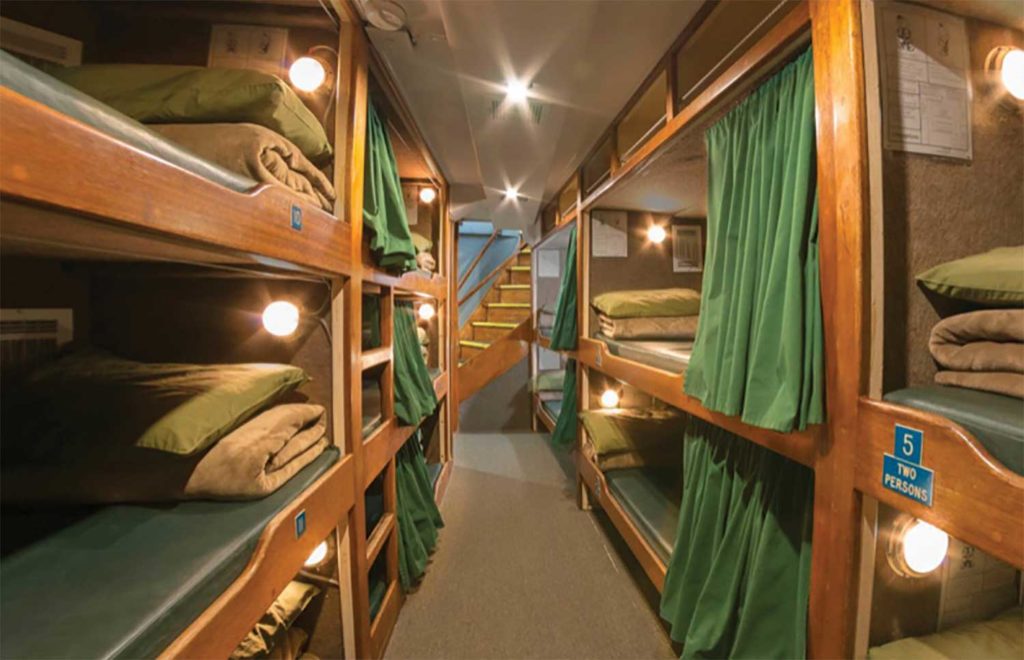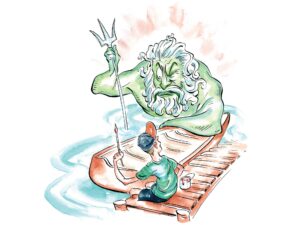
It was a quiet night aboard the 75-foot scuba-diving boat Conception, anchored on Labor Day weekend in 2019 off Platts Cove, Santa Cruz Island, some 21 nautical miles from Santa Barbara, California. The wind and swells were light, and after dinner, the 33 passengers tucked into their bunkroom after a long day of scuba diving in the clear waters that are like an aquarium filled with colorful fish, sea lions, seals, forests of kelp, and lobster. Four of the five crew also went to their bunks to prepare for the final day of diving on the three-day outing. A last crewmember finished tidying up in the galley, heading to his berth around 2:30 a.m.
Forty-five minutes later, 34 of those aboard were dead or dying.
Fire is one of the most feared disasters aboard any boat, especially because boats are surrounded by water, and the Conception tragedy is worth examining to understand its causes and effects, and to glean lessons for recreational boaters.

Conception was operating as a U.S. Coast Guard-inspected commercial passenger vessel, and thus had different regulations than a pleasure boat. One of the first discoveries made by multiple investigative agencies, including the National Transportation Safety Board and Coast Guard, is that Conception breached Subchapter T of the Code of Federal Regulations by not having someone on watch throughout the night to sound the alarm in just such a situation, but this reg doesn’t apply to recreational boats.
There are three parts to understanding the Conception tragedy. First, what happened? Second, how did it happen? Third, what can we learn?
Like many other dive and fishing boats, often called headboats or party boats, that carry large groups of enthusiasts offshore on overnight or longer voyages, Conception had a bunkroom forward on the lowest deck. In it, bunks were stacked two- and three-high Pullman-style, each with a privacy curtain. In the bow were heads with showers, as well as curved stairs leading to the main deck salon and galley above.
These stairs exited next to the galley, and the rest of the salon was devoted to bench seating and tables for dining, playing cards or lounging, with an aft exit emerging out onto the after deck. Above the salon/galley on the sun deck was the pilothouse with bunks for crew. The after deck was open, with racks for dive tanks and gear.
What Happened?
All was normal as the divers had dinner in the salon after a night dive, with some staying up late to celebrate three birthdays before heading for their berths. The captain and most of the crew turned in as well, with one remaining to clean up in the galley until 2:30 a.m., when he also went to his berth.
At 3:14 a.m., just 45 minutes later, Coast Guard Long Beach received a mayday call from the captain, nearly overcome by smoke, saying Conception was on fire with 39 souls on board, and adding, “I can’t breathe.”
According to interviews with the crew, a crewmember in the pilothouse heard a noise and went to investigate, finding the salon of the dive boat in flames.
Because the stairs from the pilothouse and sun deck were on fire, the five crew had to jump to the main deck, with one breaking his leg in three places. Finding the salon’s aft passageway also on fire, two crew went forward on the side deck, hoping to reach the salon through a forward window, but they were driven overboard by smoke and fumes.

Two other crew and the captain swam to the stern, reboarded, and opened the engine-room hatch, finding no fire. They launched a dinghy, picked up the two crew in the water, and went to a 60-foot Hatteras sport-fisher, Grape Escape, anchored nearby. From there, the captain again called the Coast Guard while two crew returned to search for survivors.
The Coast Guard scrambled to send a chopper, an 87-foot cutter and other assets, but it was a Ventura County fireboat that arrived first, with five additional fire and rescue boats joining the scene, as well as a RIB from TowBoatUS Ventura. The fire was out of control at this point, with explosions presumably coming from scuba tanks ticking off.
The anchor line soon burned through, and Conception began to drift toward the rocky shoreline. Because of its shallow draft, the TowBoatUS RIB was able to maneuver close and throw a grappling hook onto the bow. It pulled Conception off and held it in deeper water while the two fireboats continued to pump water onto the blaze. Conception eventually burned to the waterline, sinking in 60 to 65 feet of water.
Divers went down at daylight to assess the situation and, after waiting several days for wind and seas to subside, Conception was eventually raised onto a barge and sent to a boatyard, where the NTSB and Coast Guard investigations are still continuing.
Built of plywood with a fiberglass overlay in 1981, Conception was operated by a dive company called Truth Aquatics and reportedly well-maintained. It had been in full compliance from two recent Coast Guard inspections, with no problems other than an expired fire extinguisher in 2017. Guests aboard previous trips called Conception and two other boats in the Truth Aquatics fleet among the best and safest dive boats around. One called the company’s boats “immaculate.”
Conception was equipped with the mandatory fire-suppression system in the engine room, plus hoses abovedecks, and the company had installed smoke detectors on board.
How Did It Happen?
Investigators are looking at two areas of concern for both recreational skippers and commercial operators. First, the method of escape needed for those in the bunkroom, and second, how the fire started.
Under consideration are the routes of escape for those in the bunkroom. There was a narrow stairway, wide enough for one person at a time, going from the bunkroom to the forward end of the salon next to the galley. But in this case, the galley area was already on fire.
As required by Coast Guard regulations, there was a second escape hatch in the ceiling of the bunkroom, but this was also useless because it exited into the burning salon above. In addition, it was above a berth, thus requiring passengers to climb to the top bunk, then push up the hatch and exit. The hatch was just 24 inches square, which made it a squeeze, and there remains a question whether the passengers even knew of its existence. Coast Guard rules (from which Conception was exempt) require 32-inch hatches on newer vessels.

In the bunkroom, Conception had two home-style smoke detectors, like those found in any hardware store, but they were not linked together into a unified alarm system. The surviving crew in the pilothouse heard no smoke detector alarm.
Li-Ion Batteries
This brings up the cause of the fire and, while the NTSB and Coast Guard don’t expect an official report for at least a year, one intense area of focus has been li-ion batteries.
Li-ion batteries, short for lithium ion, are used to charge every manner of portable electronics, and have grown in popularity because they are lighter and offer more power for devices with high power requirements.
The downside is that they create considerable heat while recharging, which can lead to fires. If not properly vented and protected, the heat from one charging li-ion battery can set off a chain reaction with other batteries. The electrolyte inside a li-ion battery is volatile and flammable, and a catastrophic failure, called a thermal runaway, can drive the temperatures even higher. Tests show exploding batteries shooting off red-hot pieces in all directions.
Compounding that problem is that boats such as Conception were built before the modern world of digital cameras, cellphones, laptops, tablets and, in this case, dive gear that included underwater cameras, lights and scooters. Even the lowly vape cigarette uses a li-ion battery.

The original installers of the electric receptacles, in both number and placement, couldn’t foresee the new personal electronics boom, so circuitry might have been sadly undersize for the power needs, especially when used with multiplug strips. Even worse, a power strip overloaded with li-ion battery chargers and then tucked behind a couch can produce fatal results when burning plastics release cyanide, while flooring or polyvinyl-chloride seating upholstery emits deadly hydrogen chloride.
Just a year before, a sister boat of Conception had an incident where a crewmember saw a charging li-ion battery smoldering, and he tossed it overboard.
Such li-ion fires burn incredibly hot—up to 1,000 degrees F—resulting in the aforementioned chain reactions of nearby batteries. Because of four deaths and the loss of four aircraft, the Federal Aviation Administration has banned li-ion batteries from cargo holds because the crew can’t monitor them. Li-ion batteries are allowed in carry-on luggage, where passengers and crew can see and smell smoke. Even then, the FAA has recorded 265 air or airport incidents involving li-ion batteries in cargo or baggage. In one case, headphones exploded on a plane. The Navy has severely restricted li-ion batteries, banning all vaping devices on its vessels after they set off numerous fires.
What Can We Learn?
Getting Out: Just as airline crew are required to give a safety briefing before the plane takes off, there should be a captain’s briefing before you leave the dock. Be sure to include placement of fire extinguishers, life jackets and the location of emergency exits.
One question raised by investigators is whether the passengers had been properly briefed, or if the captain’s briefing didn’t mention the second escape hatch, even though it wouldn’t have been useful in the case of Conception.
Early autopsies suggest that the Conception victims died of smoke inhalation or carbon-monoxide poisoning and not burns, meaning they were overcome before they could escape.
On a pleasure boat, do your “what-ifs.” Consider how you would escape at night if your salon was on fire. What if the engine compartment was on fire? What if the galley was on fire? Make sure everyone aboard is aware of alternative escape routes and how latches and hinges work.
Post a Watch: This might be the biggest mistake made by the crew of Conception. We know they failed to have someone on a night watch, as required by federal regulations. No one will ever know, but had they adhered to the rule, it could well have averted the tragedy.
How does this apply to recreational boaters? As mentioned earlier, we’re not required by law to post a watch when overnighting. Yet there are situations like that of Conception in which rotating night-watch duty among crewmembers—so each gets some sleep—is a prudent safety step.
When at sea or on large bodies of water at night, many things can threaten safety. Anchors drag. Winds shift. Bilges flood. Other boats might not see you. And a fire might break out. A night watchman offers assurance that you can take action quickly and avoid catastrophes.
Watch It or Box It: Li-ion batteries are known as a danger on airliners and, just eight days after Conception went down, the Coast Guard issued Marine Safety Information Bulletin 008-19, which says: “Reduce potential fire hazards and consider limiting the unsupervised charging of lithium-ion batteries and extensive use of power strips and extension cords.”
The key word is “unsupervised,” which, in the case of Conception, seems to have proven deadly. Everyone aboard just plugged in multiple battery chargers and went to bed. If you absolutely must leave li-ion batteries charging overnight, consider getting one of the battery safety boxes now on the market, which isolate li-ion batteries and chargers in a fireproof box that contains heat and explosion.
In addition, make sure your 120-volt AC electrical system is prepared to handle the increased power requirements of device battery chargers, and try to eliminate both extension cords and power strips. Never leave li-ion battery chargers unsupervised, and ensure your electrical system meets ABYC standards and can handle the power demanded.
Find Your Way: An experienced skipper knows that many emergencies seem to happen in the dark of night, and the suggestion has been made that, aboard Conception, the passengers couldn’t find light switches in the smoky darkness. You aren’t going to install an exit sign like a theater, but an illuminated light switch could help your guests find a light to guide them through smoke or fumes. At the same time, your guests should have ready access to flashlights. Look for replacement illuminated light switches that run $10 to $20 at most hardware stores. Flashlights should be handy to every berth, and their location should be included in the skipper’s briefing.
Adding Extinguishers: Coast Guard regulations for recreational boats call for owners to have one B-1-type fire extinguisher aboard vessels 26 feet and under, and a minimum of two for boats between 26 and 40 feet. This is the minimum requirement. If you own a cabin boat and like to overnight at anchor or in a marina, think about adding more fire extinguishers and placing them in easily accessible locations in the berths and other key spaces belowdecks. Even if using an extinguisher isn’t enough to put out a fire, it could hold the fire back long enough to escape.
Alarming: While Conception apparently had smoke detectors in the bunk area, they weren’t linked to any system. It was only by chance that one crewmember investigated a noise and discovered the fire, since the alarms weren’t audible to the crew.

Consider a unified smoke and carbon-monoxide warning system, particularly in sleeping areas, that would sound the alarm for everyone. Any electronics shop can also tie these into the horn on your vessel, thus alerting other boats on your dock of a fire.
Extra Gear: We all know that storage is at a premium on board recreational boats, but consider adding extra safety items to your list. We’ve heard of people keeping fire blankets stowed in all berths that passengers can use to throw over a small fire or, in an extreme situation, wrap themselves in to avoid burns while trying to escape a fire.
Read Next: Marine Fire Extinguishers
The official report on the Conception tragedy probably won’t be available for more than a year because the investigating authorities are still working to find definitive answers. But every recreational boater can learn from this tragedy about how to protect their family and guests aboard their own boat in the event of a fire.
Update: Captain Found Guilty, Survivors Speak
The captain of this dive boat, P/V Conception, based out of Santa Barbara, California was found guilty in the tragedy that took 34 lives on Labor Day of 2018.
According to a release from the U.S. Attorney’s office, Jerry Nehl Boylan, 69, of Santa Barbara, was found guilty of one count of misconduct or neglect of ship officer – an offense commonly called “seaman’s manslaughter” – a crime punishable by up to 10 years in federal prison.
“This ship captain’s unpardonable cowardice led to the deaths of 34 lives on Labor Day 2019,” said United States Attorney Martin Estrada. “As the jury found, this tragedy could have been avoided had Mr. Boylan simply performed the duties he was entrusted to carry out. We hope that today’s verdict brings some solace and closure to the victims’ loved ones.”
As the ship’s captain, Boylan was responsible for the safety and security of the vessel, its passengers, and its crew. The jury found he failed in his responsibilities in several ways, including by:
- failing to have a night watch or roving patrol;
- failing to conduct sufficient fire drills and crew training;
- failing to provide firefighting instructions or directions to crewmembers after the fire started;
- failing to use firefighting equipment, including a fire ax and fire extinguisher that were next to him in the wheelhouse, to fight the fire or attempt to rescue trapped passengers;
- failing to perform any lifesaving or firefighting activities whatsoever at the time of the fire, even though he was uninjured;
- failing to use the boat’s public address system to warn passengers and crewmembers about the fire; and
- becoming the first crewmember to abandon ship even though 33 passengers and one crewmember were still alive and trapped below deck in the vessel’s bunkroom and in need of assistance to escape.
Now, according to the website, Divernet, survivors of the tragedy are speaking out. Here is a quote one survivor gave to Divernet.
“Most of the passengers had been alerted to the fire either from the smell of smoke, or by other passengers knocking on their doors to wake them. Evacuation was chaotic and we left the burning boat within 10 minutes of the manual emergency alarm being sounded.
“As the red zodiac could not start its engine, it was tied to the white zodiac by rope so that it could be towed.”
Read more survivor comments at: divernet.com
Editor’s Note: On May 2, 2024, Jerry Boylan, the disgraced captain of the dive charter boat, P/V Conception, that burned, killing 34 people off California in 2019 was sentenced to four years in prison by a federal judge in Los Angeles. Read more, here.









